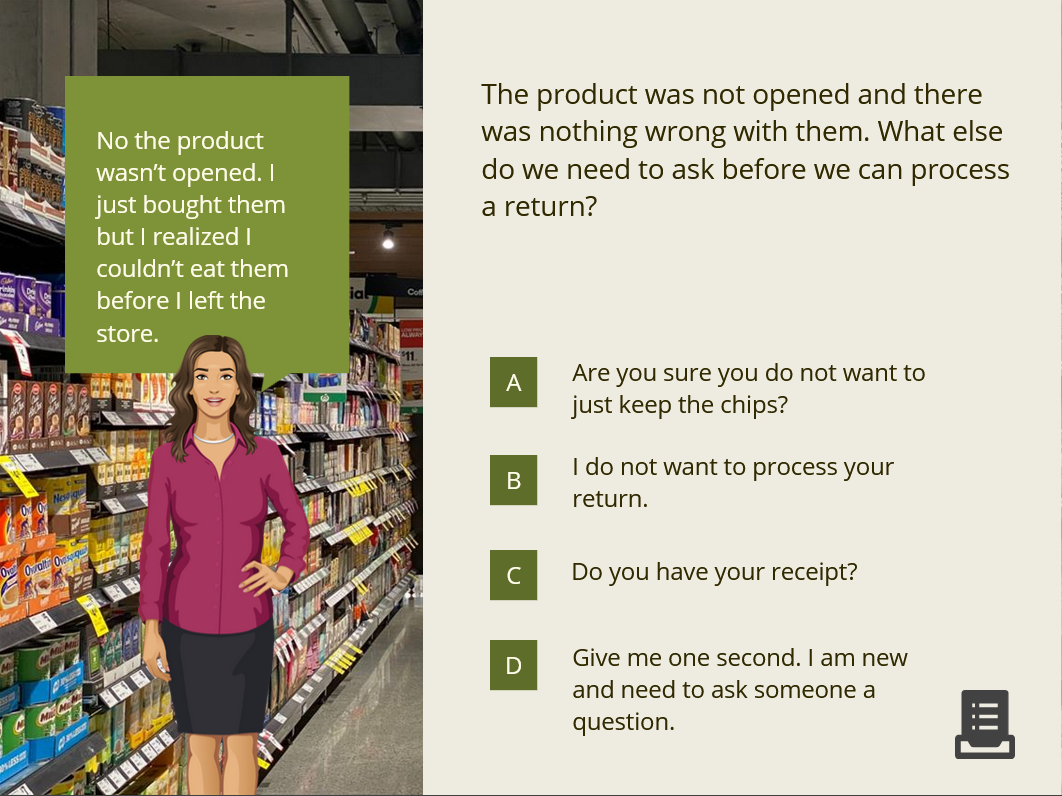Return Policy Training Overview
Created using Articulate Storyline, Canva, DaVinci Resolve, and Audacity.
This eLearning module was created to add structure to the training, allow learners to access the material on their own time, and grant them the necessary tools they need to practice the material before the in-person scenarios.
Overview and the Problem:
The training for customer service specialists at this cooperative grocery store is unstructured. To train learners on how to handle returns, the learners act out scenarios with the experienced employee acting as the customer. Learners are often confused and frustrated with the experience, admitting that they do not feel adequately trained on the material. Experienced employees will both have to explain the process and act out common scenarios with the learners. Time for training is allotted based on how busy the store is. Training in this way is time-consuming and allows for interruptions to occur during the training activities. This has created learners who do not feel confident in their abilities to process returns and mistakes about when a return should be processed.
This eLearning module was created to add structure to the training, allow learners to access the material on their own time, and grant them the necessary tools they need to practice the material before the in-person scenarios.
The Solution:
An eLearning module that focuses on formalizing necessary information, creating a structure to the return policy training, and explaining the thought process learners should have when assessing whether to process a return.
An eLearning module was chosen so that learners could access the module on a computer or mobile device away from the information desk, limiting the number of interruptions that could occur while training. Two practice scenarios are used as a form of assessment and to allow the learners to practice the knowledge before acting out the scenarios. This was to limit the amount of time necessary to do these simulations and to create a clear distinction between learning and practice.
Development:
This learning module was developed using the ADDIE (Analyze, Design, Develop, Implement, Evaluate) process and its structure was informed by Knowles’ Adult Learning Principles. It was important that the learning was more structured but gave the learner more agency in how they learned about the topic. An eLearning module allows the learner to access the information on any device that they would like. For analysis, I used informal interviews with the managers and experienced customer service representatives as well as observations from being in the performance context to create the learning goals. My ideas for the training were then synthesized into a design document that can be viewed here.
I used post-It notes as a preliminary storyboard before creating a more formal storyboard that went over what should be included within each slide. I used this storyboard to then create the eLearning module using Articulate Storyline. This authoring tool was used for its ability to create realistic scenarios that mimicked the ones the learners will face in their performance context. The assessments as scenarios fall in line with Adult Learning Theory’s problem-centered approach to learning. Learners cannot proceed through the module until they pass the scenarios at two specific points.
Finally, a video of myself introducing the topic is included to orient the learners to the subject matter as well as to build a rapport with the learners. The end of the module is also framed with a video reiterating important things to keep in mind. I chose to do this because it will still be necessary to do an in-person simulation of processing returns. I am the main person who trains these learners, so I want to create a sense of trust between us. Including myself in the learning can help make addressing topics they found difficult in the module less intimidating for the learners.
Results:
It was difficult to assess the effectiveness of the eLearning module as there were no new customer service representatives promoted at the creation of the material. Several experienced customer service representatives took the learning module and suggested information that they believe could be useful in formalizing the return policy process. Two to three cashiers completed the learning module with positive attitudes towards it, but its effectiveness could not be accurately detailed. Both the Customer Service Manager and Assistant Manager were happy with the end product.
The department agreed that the eLearning module was successful in two of its higher-value goals: to formalize how returns should be approached by customer service representatives, and to create more structure in how the learners are trained.







